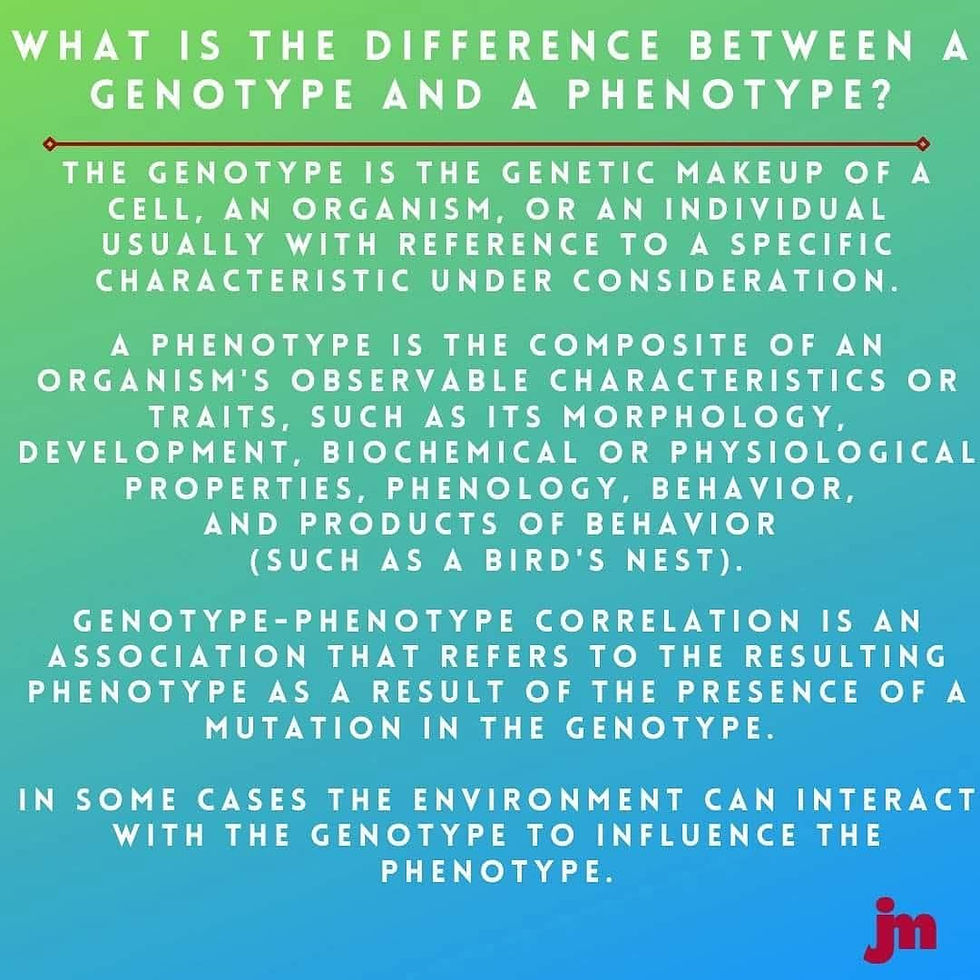
Genotype vs Phenotype
- Jul 18
- 3 min read
Todays topic is Genotype vs phenotype, which although related, have huge differences.
Biology is full of terms that are confusing even to those who’re interested in it and who study it at a high level. So, it’s natural that those of us who only had biology at school and don’t really talk about it on a daily basis, confuse scientific words and use the one when meaning the other. The fact that all these words are very similar only makes the situation worse. They sound almost the same but what’s the difference in their meanings? Genotype is the genetic material passed down from generation to generation. But phenotype is the observable characteristic of the genetic material. Todays topic is to discuss the basics of how and when, each can be used in breeding programs.
#genotype 👉 Definition: Genetic makeup of an organism.
#phenotype 👉 Definition: Observable traits and characteristics.
For most of history, the creation of populations of different types of dogs was based on phenotypic selection, the preferential mating of dogs that displayed the desired traits.
It wasn't until about 200 years ago that we realized that we could select for desirable traits more efficiently if we understood that phenotype reflects genotype, and that genes are the raw material of selection. From there, it was easy to understand that if we had a way to know which genes were in a dog, we could predict much more accurately what traits it was likely to pass on to its offspring then if we just knew the phenotype.
Chromosomes are divided into genes which are the basic units of hereditary and carry segments of DNA. The domestic dog has approximately 19,000 genes and these genes form random combinations known as a genotype. The observed measurement of a trait is called a phenotype and the phenotype is a combination of the genotype and the environment and - the interaction between the genotype and the environment. In animal breeding terms, the environment is any non-genetic external factor than can affect a dog’s performance e.g. diet, housing and exercise programme. Many of the traits that are of interest to dog breeders such as morphological and health traits are complex traits under polygenic (https://g.co/kgs/2V8PFqp) control. This means that these complex traits are influenced by many genes whose expression can be influenced through the interaction with other genes and these genes may also interact with the environment.
When developing a scientific dog breeding programme, it is important to know how much the variation of the trait is due to the genetic and environmental components. The variation of a trait that is due to transmittable genetic effects is quantified using a metric called the heritability. The heritability is a population value and can have a value between 0 and 1. The heritability is then used to estimate the Predicted Transmitting Ability (PTA) and the PTA is the genetic value that a sire or a dam can pass on to their offspring. If the PTA is known for important traits, they are a valuable tool for dog breeders when making mating decision to improve the health and welfare of their dogs, as well as traits to do with growth, speed, stamina and other traits that may be important.
As an example, traits such as hip dysplasia and elbow dysplasia have heritability values ranging between 0.01 and 0.69 depending on the dog population (Oberbauer et al., 2017). These values are less than one, which means they are not under complete genetic control, which in effect means that if a young dog develops either of these conditions it may not be the fault of the breeder as the dogs’ environment such as diet and exercise, can also contribute to these conditions.
An understanding and the application of the basic principles of scientific principle of dog breeding, can contribute to improving the health and welfare and the overall genetic sustainability of a dog population. It is important to note that the development of a scientific breeding programme for dogs will contribute to permanent and cumulative improvement over time.
References:








Comments